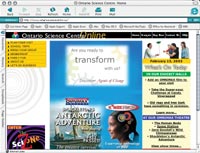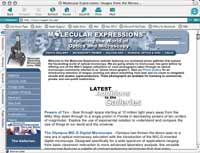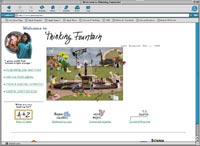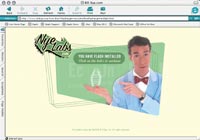|

By Lynda Scarrow
Ontario Science Centre: SciZone
www.ontariosciencecentre.ca
 The
well-known Ontario Science Centre has a section on its site called SciZone.
Here, you can slide along a timeline to follow the aging process of a
boy and girl from childhood to age 122, the age of the oldest known person.
It also provides a few responses to the question: "Why do we age?" The
well-known Ontario Science Centre has a section on its site called SciZone.
Here, you can slide along a timeline to follow the aging process of a
boy and girl from childhood to age 122, the age of the oldest known person.
It also provides a few responses to the question: "Why do we age?"
Also shown recently: papermaking, circus culture and Discover Our Rainforest,
which includes a great panoramic view of the Centre's rainforest exhibit.
It has an interesting interactive component that's only apparent when
you run your mouse over the image.
You'll also uncover games, lab experiments, and a whole host of questions
and answers, such as "Do tarantulas make your heart beat faster?"
The Home Lab section is particularly good in that it walks students through
the project, then provides a detailed explanation of the results.
Molecular Expressions:
Exploring the World of Optics and Microscopy
micro.magnet.fsu.edu
 From
looking outward into space to inward to DNA, this site is an excellent resource
for exploring the world of optics and microscopy. It offers information
on microscope basics, an explanation concerning how digital imaging has
changed the way information is gathered (a neon image of mouse intestines
effectively shows how digital photography works) and an extensive gallery
of photos takenthrough microscopes and telescopes. From
looking outward into space to inward to DNA, this site is an excellent resource
for exploring the world of optics and microscopy. It offers information
on microscope basics, an explanation concerning how digital imaging has
changed the way information is gathered (a neon image of mouse intestines
effectively shows how digital photography works) and an extensive gallery
of photos takenthrough microscopes and telescopes.
You'll want to visit the virtual microscopy page at http://micro.magnet.fsu.edu/primer/virtual/virtual.html
where you can use simulations of approximately 17 different types of microscopes.
The Online Activities for Students (http://micro.magnet.fsu.edu/optics/activities/index.html)
offers a minimum of 25 sections, including:
using media to explore light and optics
mirror, mirror on the wall: angles of reflection
animal vision
3D images and holograms
, and
lighthouses.
This Florida State University site offers hours of exploration with the
potential to learn a great deal about optics and microscopy. The information
provided, however, is geared to the older, more advanced student.
Thinking Fountain
www.sci.mus.mn.us/sln
 When
you first look at the Thinking Fountain's left-hand navigation bar, you
might think you've stumbled across a site dedicated to growing mold, which
in itself is the stuff that science projects are often made of. When
you first look at the Thinking Fountain's left-hand navigation bar, you
might think you've stumbled across a site dedicated to growing mold, which
in itself is the stuff that science projects are often made of.
Take a further look, however, and you'll discover a site chock full of
a variety of projects for children. Instructions are clear (the grainy
photos make the instructions feel like an experiment scratched out in
a field notebook) and each section has a list of supplies a child will
need to make their creations.
Some lists also include a simple explanation of any item the child may
not have seen before.
The site includes a gallery of student work, book reviews, slide shows
and an area where students can ask questions, which are answered online.
All in all, it's a great site developed by the Science Museum of Minnesota.
Nye Labs: Bill
Nye the Science Guy
www.billnye.com
 Bill
Nye's web site uses the latest web technology to promote his television
show while providing a few projects for kids. The site may trigger a child's
interest in science, but Nye passes up an opportunity to create web pages
with more substantial science-packed information. It is, however, a good
stopping point for a very short scientific visit. Bill
Nye's web site uses the latest web technology to promote his television
show while providing a few projects for kids. The site may trigger a child's
interest in science, but Nye passes up an opportunity to create web pages
with more substantial science-packed information. It is, however, a good
stopping point for a very short scientific visit.
To receive the site's full affect, you'll need to have Flash installed,
although there is a Flash-free version available as well. (The site uses
a "sniffer" that automatically checks to see if you have Flash
before displaying the version that works on your computer.)
Nye's web pages include home science projects, a question of the week
(the most recent one covered why humans get goosebumps), e-cards that
can be sent to friends, plus information about the show.
Lynda Scarrow is
the College's web editor. She can be reached at lscarrow@oct.ca.
|
![]()

